How to read the Induction Motor Nameplate data
Reading Induction Motor Nameplate sometimes very difficult and challenging because the nameplates Often get dirty, painted, and rusted as they get old. So reading motor information becomes frustrating.
You will need motor information for installation of VFD, starter design, power factor correction, connecting to load
In this article, we will discuss each parameter mentioned on an induction motor nameplate. all necessary data specified on name plate-like electrical data- voltage, current, frequency, power factor. so here we are going to see how to read the induction motor nameplate and explanation.
Electrical parameter
Voltage
This data specifies at which voltage the motor is manufactured to operate. Motor nameplate specified parameters for the motor such as power factor, efficiency, torque and current are at rated voltage and frequency. When the motor is used at other voltages than the voltage indicated on the nameplate, its performance will be affected.
Frequency
Normally, for motors, the input frequency is 50 or 60 Hz. If more than one frequency is marked on the motor nameplate, then other parameters that will differ at different input frequencies have to be indicated on the nameplate as well.
Phase
This parameter represents the number of AC power lines that supply the motor. Single-phase and three-phase are considered as the standard
Current
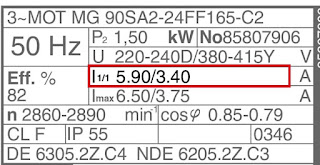
Current indicated on the motor nameplate corresponds to the rated power output together with voltage and frequency. Current may deviate from the name-plate amperes if the phases are unbalanced or if the voltage turns out to be lower than indicated.
Type
Some manufacturers use type to define the motor as single-phase or poly-phase, single-phase or multi-speed or by type of construction. Nevertheless, there are no industry standards for type.
Power factor
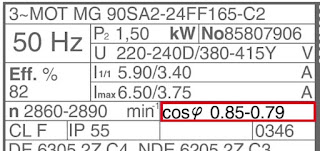
Power factor is indicated on the nameplate as either “PF” or “P .F” or cos φ. Power factor is an expression of the ratio of active power (W) to apparent power (VA) expressed as a percentage. Numerically expressed, the power factor is equal to the cosine of the angle of lag of the input current with respect to its voltage. The induction motor’s nameplate provides you with the power factor for the motor at full-load.
Mechanical Parameter
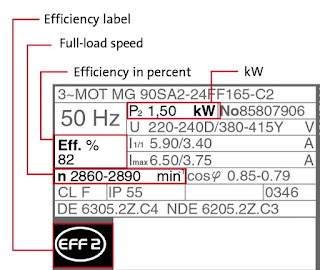
kW or horsepower
KW or horsepower (HP) is an expression of the motor’s mechanical output rating – that is its ability to deliver the torque needed for the load at rated speed.
Full-load speed
Full-load speed is the speed at which rated full-load torque is delivered at rated power output. Normally, the full-load speed is given in RPM. This speed is sometimes called slip-speed or actual rotor speed.
Performance Data
Efficiency
Efficiency is the motor’s output power divided by its input power multiplied by 100. Efficiency is expressed as a percentage.
Efficiency is guaranteed by the manufacturer to be within a certain tolerance band, which varies depending on the design standard, eg IEC or NEMA. Therefore, pay attention to guaranteed minimum efficiencies, when you evaluate the motor’s performance.
Duty
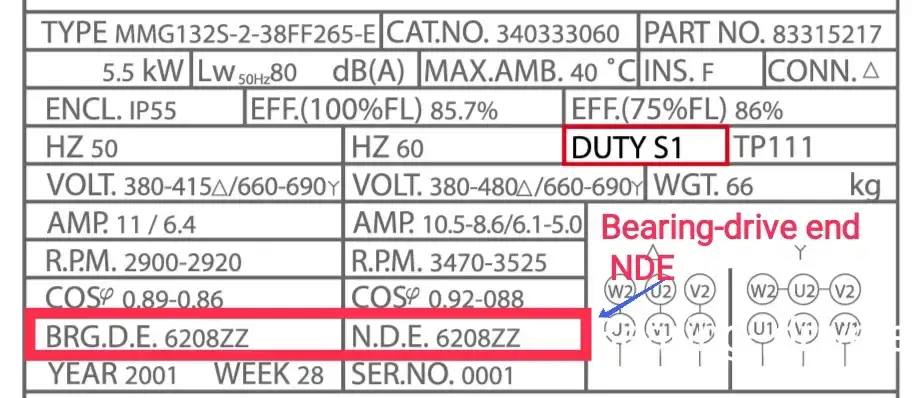
This parameter defines the length of time during which the motor can carry its nameplate rating safely. In many cases, the motor can do it continuously, which is indicated by an S1 or “Cont” on the nameplate. If nothing is indicated on the motor name-plate, the motor is designed for duty cycle S1.
Reliability
Insulation class
Insulation class (INSUL CLASS) is an expression of the standard classification of the thermal tolerance of the motor winding. Insulation class is a letter designation such as “B” or “F”, depending on the winding’s ability to survive a given operating temperature for a given life.
The farther in the alphabet, the better the performance. For instance, a class “F” insulation has a longer nominal life at a given operating temperature than a class “B”.
Maximum ambient temperature
The maximum ambient temperature at which a motor can operate is sometimes indicated on the nameplate. If the maximum is 40°C for EFF2 motors and normally 60°C for EFF1 motors. The motor can run and still be within the tolerance of the insulation class at the maximum rated temperature.
Altitude
This indication shows the maximum height above sea level at which the motor will remain within its design temperature rise, meeting all other nameplate data.If the altitude is not indicated on the nameplate, the maximum height above sea is 1000 meters.
Construction parameter
Enclosure
Enclosure classifies a motor as to its degree of protection from its environment and its method of cooling. The enclosure is shown as IP or ENCL on the nameplate.
Frame
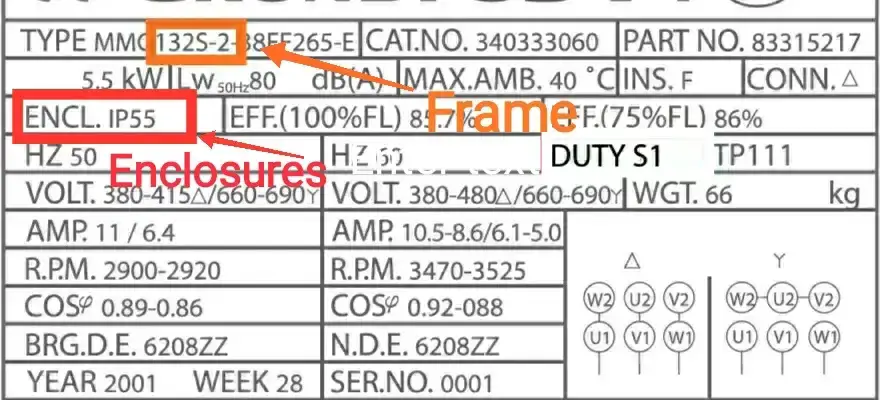
The frame size data on the nameplate is an important piece of information. It determines mounting dimensions such as the foot hole mounting pattern and the shaft height. The frame size is often a part of the type designation which can be difficult to interpret because special shaft or mounting configurations are used.
Bearings
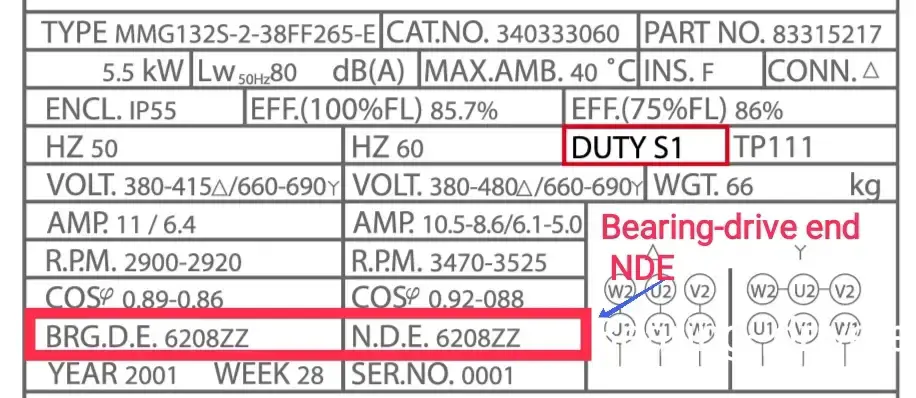
Bearings are the component in an AC motor that requires the most maintenance. The information is usually given for both the drive-end (DE) bearing and the bearing opposite the drive-end, nondriver (NDE).
Read Also….
Induction Motor Braking
Universal Motor
3 Point Starter
Reference :Grundfos Motor book